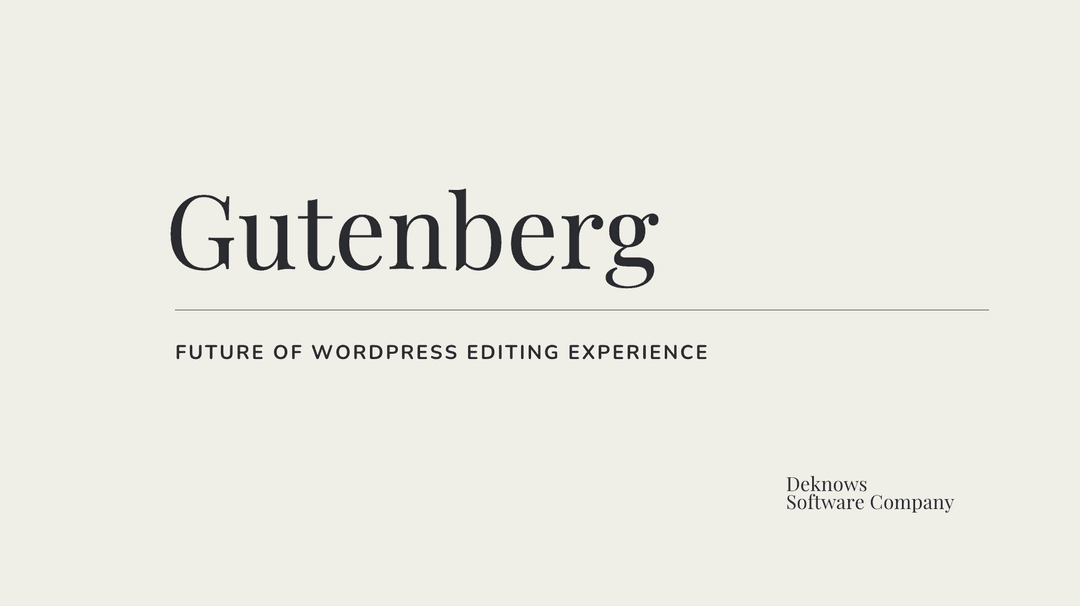Why Gutenberg WordPress Development is Promising
Read time: 10 minutes
Hamad K
Oct 25, Fri

Why Gutenberg WordPress Development is Promising: Exploring Key Advantages and Custom Widget Potential
Gutenberg has transformed the WordPress editing experience with its block-based approach, bringing more flexibility and creativity to the forefront.
This shift in development enables not only a more user-friendly experience but also opens up exciting possibilities for developers to enhance and expand website functionality. Here’s why Gutenberg WordPress development is so promising, with examples highlighting its versatility, and a look into our own experience building custom widgets that empower website creators.
1. Enhanced Flexibility for Developers and End-Users
- Gutenberg’s block editor revolutionizes content creation in WordPress by replacing the traditional editor with a block-based system. This approach allows users to select, configure, and arrange content blocks, making layout design far more intuitive. For developers, this modular approach means we can create custom blocks tailored specifically to a client's needs.
- Example: A healthcare or pharma company might need customizable testimonial blocks or unique call-to-action blocks with specific therapeutic colors and designs. Gutenberg allows us to build these blocks to specification, giving clients full control over presentation without the need for code.
2. Improved Performance and Code Optimization
- The Gutenberg editor is highly optimized for performance, which is essential in today's speed-focused web environment. It’s built using React, a popular JavaScript library, allowing for faster loading times and a smoother editing experience.
- Example: Pharma sites benefit greatly from performance-optimized product blocks, which load faster and can be customized to dynamically showcase products, categories. This contributes to a seamless browsing experience, encouraging visitors to explore more.
3. Empowering Site Owners with a Visual Editing Experience
- Gutenberg bridges the gap between content creators and developers by enabling a true What You See Is What You Get (WYSIWYG) experience. It means that non-technical users can create complex layouts without relying on a developer, reducing dependency and saving time and resources.
- Example: A pharma website with various product types, and custom fields can benefit from Gutenberg by using listing blocks. Site owners can visually edit and arrange property listings, reducing time spent on content updates.
4. Streamlined Integration of Custom Widgets for Enhanced Functionality
- Gutenberg is not only a visual editor but also a flexible framework that developers can extend with custom widgets and blocks. At our development agency, we’re leveraging this by building custom widgets that cater to specific business needs, including enhanced interactivity and unique designs. These custom widgets empower site owners to add distinctive content elements, providing more creative freedom and boosting engagement.
- Example: We’ve developed custom widgets for client websites that integrate social media feeds, product sliders, and advanced analytics blocks. These additions allow companies to dynamically showcase the latest content, promotions, or statistics, enhancing user engagement while keeping everything consistent with the site’s design.
5. Consistent Design and Reusability of Blocks
- Gutenberg enables the creation of reusable blocks, making it easy for designers and developers to ensure a consistent look and feel across multiple pages. This approach not only enhances branding but also improves usability, as content creators can simply drag-and-drop pre-defined blocks instead of creating them from scratch.
- Example: For a leading pharma website, we developed a set of reusable blocks for standard elements. This allows the company to maintain a cohesive design while adding new content, significantly streamlining content updates and brand consistency.
How Our Custom Widgets are Making an Impact:
At our agency, we’re capitalizing on Gutenberg’s potential by building tailored widgets that enhance the editing experience and expand the functionality of our clients’ websites. By developing custom blocks that align with their branding and unique requirements, we’re giving clients the tools to create richer and more interactive pages effortlessly. Whether it’s dynamic content, tailored layouts, or interactive media components, these custom widgets are empowering clients to maintain and update their websites independently, achieving their business goals with minimal technical support.
FAQ's on Gutenberg Wordpress Development:
1. How is Gutenberg different from other WordPress editors and plugins?
Gutenberg is a block-based editor, meaning it allows you to add, rearrange, and customize different content blocks (e.g., text, images, buttons) on your page easily. Unlike classic editors or traditional plugins, Gutenberg’s modular structure provides a more visual, drag-and-drop experience, making it highly customizable without additional code.
2. Why is Gutenberg faster and more efficient than other page builders?
Gutenberg is built into WordPress and developed with React, making it more lightweight and faster to load than many third-party page builder plugins. Since it doesn’t rely on extra resources and scripts like traditional page builders do, it results in quicker page loading times and better site performance.
3. Can Gutenberg handle large and complex websites?
Yes, Gutenberg is designed to be scalable and can handle websites of all sizes, from simple blogs to large corporate sites. Because it’s modular and built directly into WordPress, it scales naturally with WordPress updates, allowing developers to add custom blocks for unique site functionalities without compromising site speed or performance.
4. How does Gutenberg contribute to website scalability?
Gutenberg allows developers to create reusable custom blocks that can be applied across multiple pages, ensuring consistency while minimizing repetitive work. This reusability helps sites scale more effectively by allowing web admins to build new pages or sections quickly, even as the site grows.
5. Is Gutenberg SEO-friendly compared to other editors?
Yes, Gutenberg is SEO-friendly. The block-based structure aligns well with WordPress’s SEO capabilities, allowing for structured content layouts that are easier for search engines to index. Since Gutenberg is lightweight, it also supports faster page loading times, which contributes positively to SEO.
6. How customizable is Gutenberg compared to other WordPress plugins?
Gutenberg’s flexibility in creating custom blocks allows developers to build exactly what clients need without extra dependencies. With Gutenberg, we can create tailored widgets and layouts that match specific brand styles and functionalities, which isn’t always possible with pre-made plugins.
7. How does Gutenberg improve content management for non-technical users?
With its drag-and-drop interface, Gutenberg simplifies content management for users without coding skills. Blocks can be added, arranged, and customized intuitively, making it easy for site admins to update or add content while maintaining consistent styling and structure.
8. Is Gutenberg compatible with third-party plugins and themes?
Yes, Gutenberg is designed to be compatible with a wide variety of WordPress plugins and themes. Many plugin developers now offer Gutenberg-compatible blocks, and themes are increasingly optimized for Gutenberg, making it a seamless choice for most WordPress setups.
9. How does building custom widgets in Gutenberg benefit my site?
Custom widgets in Gutenberg allow you to expand your site’s functionality in ways that are unique to your brand. Instead of relying on a one-size-fits-all plugin, custom widgets can be designed to suit specific needs, enhance user engagement, and improve overall site performance.
10. What makes Gutenberg a long-term, sustainable choice for my WordPress site?
Gutenberg is an integral part of WordPress’s roadmap and will continue to be updated and optimized by the WordPress team. As WordPress evolves, Gutenberg will remain compatible with future versions, making it a reliable and sustainable option for long-term site management.
Final Thoughts: The Future is Block-Based
Gutenberg is reshaping the landscape of WordPress development, proving that flexibility and efficiency can go hand-in-hand. As we look toward the future of block-based design, the possibilities for custom solutions like tailored widgets and unique layouts continue to expand, offering brands unprecedented control and creativity.
Interested in Publishing your knowledge and sharing it with the world?


We thrive by partering with visionary brands and driven individuals.
Say hello 👋